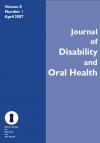Journal of Disability and Oral Health

- Cover Date:
- April 2007
- Print ISSN:
- 1470-8558
- Electronic ISSN:
- 1754-2758
- Vol:
- 8
- Issue:
- 1
Editorial
The recent launch of A Commissioning Tool in Special Care Dentistr y recognises that ‘tool kits’ for PCTs commissioning specialised services are useful in formulating specific standards of care. They are of particular use for services that span multiple settings, represent an NHS priority and may have high variability in service provision. Furthermore, the service may have an associated high volume or cost, connected with delivery of care. With the major changes to NHS dentistry PCTs’ have focused mainly on securing contracts with primary dental care practitioners to provide access to care. The lack of understanding of the oral health needs of vulnerable groups amongst many Health Service Commissioners is acknowledged. It is of paramount importance that dental leads at PCT and SHA level, need to be able to make informed decisions in the procurement of high quality services, to secure the oral health of vulnerable groups. BSDH secured funding from the Department of Health and developed the ‘tool kit’ with a working group with wide representation. The Commissioning Tool provides clear guidance on a commissioning strategy, which has four key elements: • A patient centred service which aims to provide and maintain optimum oral health • Integrated front line care which is organised around the needs of the vulnerable adult, rather than professional boundaries • A seamless process which leads to effective joint working at a PCT level • Joint planning and Commissioning at an SHA level. Prevention lies at the centre of the strategy, with a focus on the development of oral care plans, early intervention and improved information about services. Effective joint planning and commissioning is at the heart of improving outcomes for the oral care of vulnerable groups. At a PCT level, commissioning of services should be person centred, with the emphasis on prevention. Dental leads at the PCT will have an important role, in conjunction with the specialist in SCD, to map the services available within the locality, identify resources and set the agenda to improve oral health through a local delivery plan. Mergers of PCTs allow for development of clinical leadership in SCD, transcending traditional boundaries and ensuring equity for vulnerable adults across primary and secondary care. A proposed hub and spoke approach will centralise specialist advice and clinical care, ensuring equity across a larger geographical area, with the provision of outreach clinics where possible. Consequently, patients should be treated by the right person, in the right place, at the right time. The important role that service users play in the planning and development of local SCD services is fundamental to this. Oral health needs of vulnerable adults can be improved by the development of integrated care pathways and a model of best practice is presented within the document. All services should have a robust clinical governance framework. The seven domains outlined in the Health Care C o m m i s s i o n document, Standards for Better Health are sug gested for monitoring standards of care and outcomes. Examples of a Service Level Agreement and service specification are provided, as well as appendices on best practice within the dental surgery and under general anaesthesia. The Dental Lead at the SHA will have responsibility for the collective commissioning of secondary and tertiary ser vices, to secure the oral health needs of the population with the most complex needs or those requiring access to specialist facilities and multidisciplinary teams. Planning and commissioning arrangements will have to take into account cross boundary issues, by working with these partners and agreeing solutions to facilitate patient choice. Dental leads will play a key role in developing effective networks between education, social services, workforce development and clinical network support. Inter- and intra-agency working will secure optimum oral health, for example its integration into the training of carers. Identifying SCDrelevant research priorities will be central to pinpointing areas of unmet need, developing evidence-based practice and planning future services. The document can be downloaded from the BSDH we bsite www.bsdh.org.uk. A copy will be sent to the Dental Lead at every PCT and SHA in England and all Clinical Directors of Salaried Dental Services. Furthermore, Phil Friend, Chairman of RADAR and Lord Rix Chairman of Mencap, have agreed to publicise this document through the voluntary sector. With access the main priority for PCT Commissioners, it is of paramount importance that the oral health needs of vulnerable groups are not forgotten and the document outlines all the activities necessary for the effective commissioning of SCD and the expected standards and best practice in the UK. Dr Vanita Brookes Director of Special Care Dentistry and Salaried Dental Services, Lancashire Teaching Hospitals NHS Foundation Trust
- Article Price
- £15.00
- Institution Article Price
- £15.00
- Page Start
- 2
- Page End
- 2
- Authors
Articles from this issue
- Title
- Pg. Start
- Pg. End
- An analysis of the pattern of dental treatment provided for patients with disabilities requiring treatment under general anaesthesia
- 9
- 12
- A longitudinal study of palatal plate therapy in children with Down syndrome. Effects on oral motor function
- 13
- 19
- Dyslexia and errors of left-right discrimination in undergraduate dental and postgraduate orthodontic students
- 23
- 27
- Delayed replantation of avulsed incisors in a child with cerebral palsy and epilepsy – a case report
- 31
- 33
- Using large numbers can overwhelm efforts to secure care for children with special health care needs. A case study in the USA
- 34
- 36
- Preparing a child with autism for dental prophylaxis using structured and instructional methods: a case report
- 45
- 47
